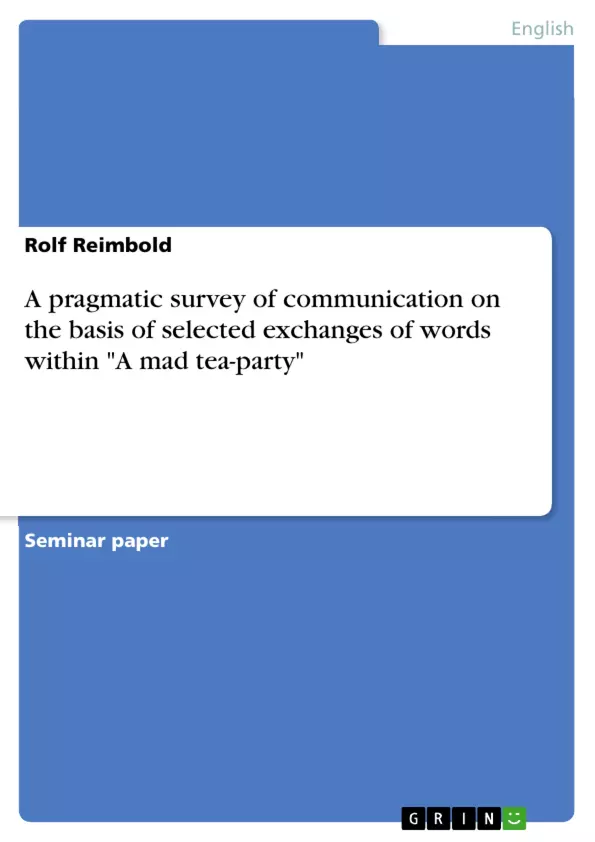Imagine a foursome sitting on a dinner table which is laid out with delicious afternoon tea items. They are enjoying the splendid weather and carrying on a nice conversation with each other. By all means, this is absolutely not a fitting description of what is happening during the MAD TEA-PARTY, a chapter of 'Alice’s Adventures in Wonderland'. Charles Lutwidge Dodgson is the author of both this book and 'Through the Looking-Glass – and what Alice found there', and is better known under the nom de plume Lewis Carroll. From now on, I am going to refer to him by this pseudonym.
There are several points that make this particular tea-party so special. First and foremost, it has to be specified that the group of four gathered around the table are not all human beings. In fact, there is just Alice who fits into this category. The other three are Wonderland creatures: the Mad Hatter, the March Hare and the Dormouse. Having come to this realization, it is easier to understand why the latter are often behaving peculiarly by human standards.
The fact that Lewis Carroll has come up with this fanciful, witty and ingenious chapter shows his great skills in making language an instrument that helps him not only to entertain and amuse, but also to cast doubt on what seems to be irrefutable and to make the reader ponder.
Since, from the first time I read Carroll’s successful novel, it was this particular chapter I liked most, I am very interested in learning more about it. First of all, I want to find out how the time in which Alice in Wonderland was written has influenced the story and its main character, Alice. As this little girl is not the only interesting character in the book, I am going to devote myself to the March Hare and the Mad Hatter afterwards. Not only do I want to take a closer look at their personalities, but I will also scrutinize their language when they are speaking to Alice. For this purpose, I want to refer to two of Paul Watzlawick’s axioms. Last but not least, I am going to find out what is understood by the linguistic phenomenon of implicature and how this is connected with the MAD TEA-PARTY.
Inhaltsverzeichnis (Table of Contents)
- Introduction
- The importance of being tactful - the Victorian Era and its influence on Alice
- Two queer fish: the March Hare and the Mad Hatter
- Different perceptions of starting points
- “All that glisters is not gold”
- One cannot not communicate
- Implicature – the addressee has to decode the message
- Conclusion
Zielsetzung und Themenschwerpunkte (Objectives and Key Themes)
This paper examines the MAD TEA-PARTY chapter of Alice's Adventures in Wonderland through a linguistic lens, focusing on the interplay of language and meaning within this particular scene. It aims to analyze how the Victorian Era, particularly the importance of etiquette and social interaction, influenced Alice's character and the overall narrative.
- Victorian Era influence on Alice's character
- Linguistic analysis of the March Hare and the Mad Hatter
- Watzlawick's axioms and their relevance to the MAD TEA-PARTY
- The concept of implicature in communication
- Alice's development and growth through interactions with Wonderland creatures
Zusammenfassung der Kapitel (Chapter Summaries)
The first chapter introduces the MAD TEA-PARTY, contrasting it with a typical afternoon tea setting. It also establishes the unique characteristics of the characters: Alice, the Mad Hatter, the March Hare, and the Dormouse. This chapter sets the stage for exploring the linguistic and social dynamics within the scene.
The second chapter explores the influence of the Victorian Era on Alice's character. It highlights the emphasis on proper etiquette and social interaction during that time and how these ideals shape Alice's behavior in the story. The chapter also examines the specific context of Alice Liddell, the real-life inspiration for the character, and her own Victorian upbringing.
The third chapter analyzes the March Hare and the Mad Hatter as figures of linguistic interest. It delves into the origins of their names, connecting them to real-world proverbs and sayings. The chapter also explores how their peculiar behaviors and language challenge Alice's understanding of communication.
The fourth chapter examines the concept of punctuation in communication, drawing upon Watzlawick's axioms. It highlights how different interpretations of the same event can lead to misunderstandings and conflict. The chapter also explores how this concept relates to the MAD TEA-PARTY and the characters' contrasting perspectives.
Schlüsselwörter (Keywords)
The primary focus of this paper lies in the analysis of communication within the MAD TEA-PARTY scene in Alice's Adventures in Wonderland. Key concepts include Victorian Era social etiquette, linguistic analysis of Wonderland characters, Watzlawick's axioms, implicature, and Alice's character development.
- Citar trabajo
- Rolf Reimbold (Autor), 2011, A pragmatic survey of communication on the basis of selected exchanges of words within "A mad tea-party", Múnich, GRIN Verlag, https://www.grin.com/document/191198



